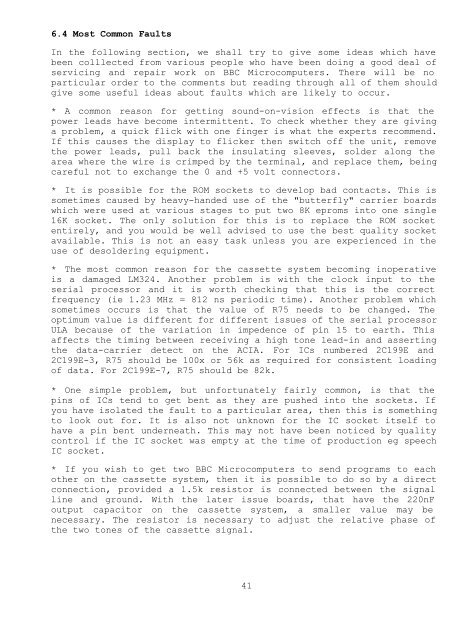BBC Microcomputer Service Manual Oct 1985 Section 1 BBC Micro ...
BBC Microcomputer Service Manual Oct 1985 Section 1 BBC Micro ...
BBC Microcomputer Service Manual Oct 1985 Section 1 BBC Micro ...
Create successful ePaper yourself
Turn your PDF publications into a flip-book with our unique Google optimized e-Paper software.
6.4 Most Common Faults<br />
In the following section, we shall try to give some ideas which have<br />
been colllected from various people who have been doing a good deal of<br />
servicing and repair work on <strong>BBC</strong> <strong><strong>Micro</strong>computer</strong>s. There will be no<br />
particular order to the comments but reading through all of them should<br />
give some useful ideas about faults which are likely to occur.<br />
* A common reason for getting sound-on-vision effects is that the<br />
power leads have become intermittent. To check whether they are giving<br />
a problem, a quick flick with one finger is what the experts recommend.<br />
If this causes the display to flicker then switch off the unit, remove<br />
the power leads, pull back the insulating sleeves, solder along the<br />
area where the wire is crimped by the terminal, and replace them, being<br />
careful not to exchange the 0 and +5 volt connectors.<br />
* It is possible for the ROM sockets to develop bad contacts. This is<br />
sometimes caused by heavy-handed use of the "butterfly" carrier boards<br />
which were used at various stages to put two 8K eproms into one single<br />
16K socket. The only solution for this is to replace the ROM socket<br />
entirely, and you would be well advised to use the best quality socket<br />
available. This is not an easy task unless you are experienced in the<br />
use of desoldering equipment.<br />
* The most common reason for the cassette system becoming inoperative<br />
is a damaged LM324. Another problem is with the clock input to the<br />
serial processor and it is worth checking that this is the correct<br />
frequency (ie 1.23 MHz = 812 ns periodic time). Another problem which<br />
sometimes occurs is that the value of R75 needs to be changed. The<br />
optimum value is different for different issues of the serial processor<br />
ULA because of the variation in impedence of pin 15 to earth. This<br />
affects the timing between receiving a high tone lead-in and asserting<br />
the data-carrier detect on the ACIA. For ICs numbered 2C199E and<br />
2C199E-3, R75 should be 100x or 56k as required for consistent loading<br />
of data. For 2C199E-7, R75 should be 82k.<br />
* One simple problem, but unfortunately fairly common, is that the<br />
pins of ICs tend to get bent as they are pushed into the sockets. If<br />
you have isolated the fault to a particular area, then this is something<br />
to look out for. It is also not unknown for the IC socket itself to<br />
have a pin bent underneath. This may not have been noticed by quality<br />
control if the IC socket was empty at the time of production eg speech<br />
IC socket.<br />
* If you wish to get two <strong>BBC</strong> <strong><strong>Micro</strong>computer</strong>s to send programs to each<br />
other on the cassette system, then it is possible to do so by a direct<br />
connection, provided a 1.5k resistor is connected between the signal<br />
line and ground. With the later issue boards, that have the 220nF<br />
output capacitor on the cassette system, a smaller value may be<br />
necessary. The resistor is necessary to adjust the relative phase of<br />
the two tones of the cassette signal.<br />
41

















